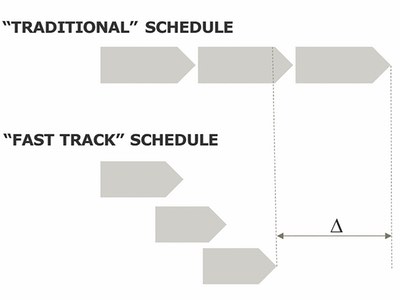Design and build projects in the life sciences industry are often challenging; they need fast execution and the design process is unpredictable. These are complex projects that required careful consideration every step of the way, from the drawing board to construction.
In a move to provide clients with an alternative to shorten the time from design to completion, engineering consultancy company Ramboll has created a Fast Track model.

Figure 1: Fast Track concept
The concept, developed at the Life Science and Pharma Department, is a project delivery strategy where construction commences before the design is completed, and where the number of sequential relationships is reduced and replaced with parallel relationships.
The model is divided into three essential phases: planning, design and execution. Each phase contains elements that are developed to shorten the time by at least one year from design to completion.
Time savings related to use of the Fast Track model depend on the project setup and client’s decision to take the risk of assumptions made in the design phase. Therefore, in the initial phase the chosen change in time (Δ) (see figure 1) needs to be aligned with the related means.
Project flow
The methodology behind fast-tracking is executed by an iterative process rather than a linear process as seen in the traditional approach.
The loop process enables the project team to run tasks simultaneously, speeding up the progression of the project. To support this project flow, the team uses traditional tools such as flow analysis, agile planning processes, 3D, 4D, 5D models and mock-ups to save time by overlapping the design and construction phases of the project.

Figure 2: Fast Track model showing examples of key elements in the three phases of the execution
In the Fast Track model, the company staff joins forces with the client’s team and other key project stakeholders to develop a strategic design and robust project execution process. Likewise, the short and restricted design schedule means that the first 3D model must be based on several assumptions and estimates, which demand active engagement in the development of the model to provide a sufficiently accurate basis for the necessary decisions and dialogue to come.
Some changes must be incorporated during the execution phase, but this is an expected cost accounted for in the initial budget.
Managing opportunities and risks
While the Fast Track model can shorten a project’s schedule, it is of utmost importance to carefully weigh the risks prior to making the decision regarding whether fast-tracking is appropriate for the context of the project.
The model execution needs certain conditions to meet expectations: contingency in fast-tracking needs to be higher than in traditional projects. If the conditions for the project in the process are not met and cannot be met by the client, a value engineering process is executed.

Figure 3: Fast Track project flow
However, despite the higher contingency level associated with the Fast Track model, the approach carries great opportunities for clients as the potential for a higher profit because of a faster facility construction and the possibility to start production process earlier compared to normal project execution.
The Fast Track model should be based on a relationship of trust between the client and the engineering service provider, and there must be a high degree of flexibility and readiness to implement changes at any time in the project. The Fast Track model works on how to assure this relationship.
Other keys to the success of a Fast Track project is committed management, user involvement, selection of technology and materials along with trained manpower, proper planning and coordination at a greater scale compared with traditional projects. Most importantly, communication is a vital element to make Fast Track projects run smoothly.
Fast-tracked projects
Throughout the past eight years, the Fast Track approach has been deployed for several projects, most notably Novo Nordisk's Purification Pilot Plant, and pharmaceutical launch plant facility for the world's first protein-based diabetes tablet, and new veterinary preparedness BSL 3 facilities at the Technical University of Denmark.
Fast-tracking was selected for the SSI project because existing facilities are not available for use, and a new infrastructure was urgently needed.

Figure 5: Model of the veterinary preparedness building at SSI, Denmark
The SSI Fast Track project (see Figure 5) comprised BSL-3/OIE-4/GMO-2 laboratories to allow operators to safely work with various types of dangerous diseases in veterinary animals, including foot-and-mouth disease and swine fever, as well as other serious infectious diseases.
The first step of the SSI project was to determine the scope: what type of construction is needed. By focusing on the needs, it was possible to incorporate a contingency budget. In addition, a multifunctional team was put together to make decisions in a timely manner and put the fast track model into action.
The greenfield veterinary preparedness building is under construction. Time from concept design to commissioning will be executed in less than two years, thus shortened substantially, approximately 1-2 years, compared to benchmark projects. Accelerated delivery of this magnitude is also relevant in the pharmaceutical industry, where minimising the time-to-market is very valuable for the client.
N.B. This article is featured in the February 2020 issue of Cleanroom Technology. Subscribe today and get your print copy!
The latest digital edition is available online.
